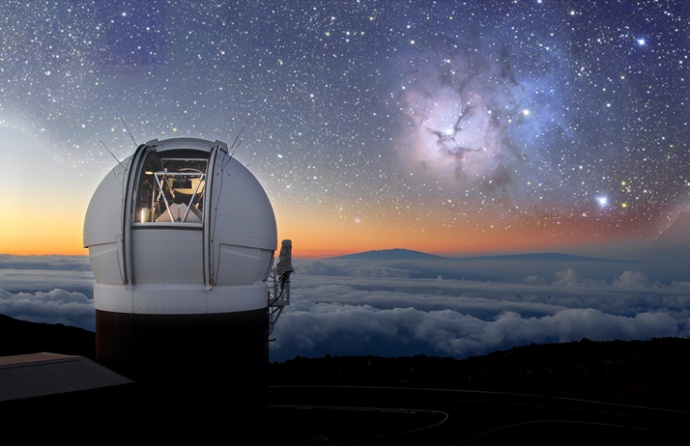$3M Gift Prevents Layoffs and Cuts to Pan-STARRS Program

Courtesy image: Photo of the Pan-STARRS 1 telescope atop Haleakalā, Maui by Rob Ratkowski. Photo montage by Karen Teramura using an image of the Trifid Nebula taken with this telescope.
By Wendy Osher
The Pan-STARRS space program, which operates the powerful PS1 telescope atop the summit of Haleakalā on Maui is the recipient of an anonymous $3 million gift.
Officials from the UH Institute for Astronomy say the funding will help the program survive cuts earmarked by Congress last year, and allow astronomy research to continue.
Before receiving the donation, officials said they were looking at having to lay off a team and halt the 2-telescope system project.
Now officials say, the funding will support construction plans, pay for salaries, preserve science jobs in Hawaii, and bring new knowledge to the world through the most powerful wide-field imaging system on the planet.
“Having already invested $80M in this project, it would have been a tragedy to let this program die, especially since we are so close to finishing,” said Günther Hasinger, director of the UH Institute for Astronomy.
“Having to lay off our staff would have had long-term implications for Hawaii’s international leadership in astronomy. It has taken years to build up the qualified team we have here and would take years to rebuild our areas of expertise. Our team members and indeed our entire research community are deeply grateful to our donors for funding this research and literally saving jobs,” said Hasinger.
Since it became operational in 2010, the PS1 telescope has discovered more than 345 near-Earth asteroids, and 19 previously unobserved comets.
The Institute for Astronomy at UH Mānoa is building a second telescope, PS2, nearby–about 50 feet north of PS1. It is considered the second component to the project initiative.
According to the Institute for Astronomy website, under normal operation PS1 and PS2 will be pointed at the same patch of sky. Scientists say resulting images would be stacked, resulting in significant improvements in signal to noise ratio and faster elimination of detector artifacts.
“Once PS2 is completed this year, the Pan-STARRS system will be by far the most powerful wide-field imaging system in existence,” said Dr. Nick Kaiser, principal investigator of Pan-STARRS at IfA. “This project involves multiple experts from around the globe and is critical to the science community’s ability to fully utilize new technology and tools being brought online,” said Dr. Kaiser.
“The donors saw this partnership as an opportunity to help advance the research economy in Hawai‘i,” said UH Foundation Vice President for Development Greg Willems.
“The University of Hawai‘i is committed to doubling the research production of the University over the next decade. Critical to that plan is retaining and recruiting extraordinary talent. The Pan-STARRS team that had been assembled after years of strategic recruitment was at risk of being lost, and the donors recognized the need to preserve this team,” said Willems in a media release.









